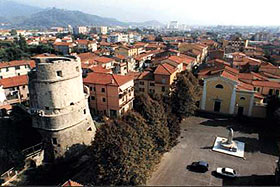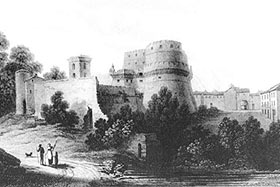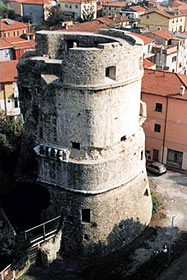Avenza Fortress
 |
 |
Left: The ruins of the fortress today ... |
Photo by 'PHOTO STUDIO 98' © 2002 Avenza sul Web.
Avenza, dominated by the imposing ruins of its fortress, rises in the commune of Carrara. It is reacheable, from Florence, following the Motoway A11 Firenze-Mare until the connection with the A12 Livorno-Genova. Exit at 'Massa' and following the indications for Marina di Massa we reach our destination after approximately 4 kilometers.
 |
Its optimal position along the ancient Via Aemilia Scauri (then called ' Romea' or 'Francigena '), and nearby the Tyrrheanian Sea, only about 3 Km far from the ancient city of Luni, the city known a great development in the Middle Ages: like center for the export of the marble, trading port for varrious goods and cattle. In the 13th century Avenza become part of the Vicariage of Carrara, the town was encircled by fortified walls and its military strategic importance grow. Its castle, built leaning against the city walls, in the successive centuries was strengthened: in 14th century by Castruccio Castracani, Lord of Lucca, and in 15th by the powerful family of the Marquises Malaspina. In the second half of 1500 Alberico Cybo Malaspina drained surroundings plain and restructured all the fortifications. In 1848 the inhabitants of Avenza tried to get independence from the commune of Carrara, attempt repeated many times always without success.
O f the fortress, only the great tower survive today. It is attributed to the works carried on by Castruccio Castracani, it shape is the result of a series of rebuildings and additions made on the ancient castle operated during the 15th, 16th and 17th century to withstand the new fire arms. After the unity of Italy the fortress was sold from the Italian State to private in order to use it as stone quarry and in 1883 only the intervention of the German historian Theodor Momsen saved it from the total destruction. Before its 'scientific disassemmbly' it was formed by three great round and a quadrangular towers. In 1859 the opening of a new road separated the fortress from the other main part of the castle-complex, the so called 'Casino del Principe', a sixteenth-century fortified manor joined together with one of the angle towers of the town walls. It still exist today, although deeply altered, and on its facade can be seen an headstone coming from the castle chapel. Other remnants of the fortifications are the gate upstream the village and fragments of the town-walls. Here you can have an idea of as Avenza appeared when its fortifications were still integral:
 More Informations on Avenza sul Web |
| Back to Homepage |
| Back to Castles Index |